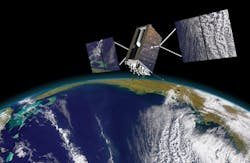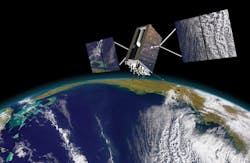The U.S. military has been involved on an extended campaign to modernize its electronic systems, including a system that many civilians rely upon as well, the Global Positioning System (GPS). As part of improved security for the GPS constellation of satellites, the GPS Ground Operational Control System (OCS) is being enhanced for use with Military Code (M-Code) encrypted signals as part of Space Force’s M-Code Early Use (MCEU) upgrade.
The upgrade involves working with the Contingency Operations (COps) upgrade from Lockheed Martin and 21 M-Code-capable GPS satellites—including the first two GPS III satellites designed and supplied by Lockheed Martin—until the next-generation ground OCS is available. The upgrade allows the satellites and system to work with M-Code and enhanced user equipment prior to the fielding of next-generation ground control systems, making the military GPS constellation more difficult to hack and jam.
M-Code-encrypted GPS signals help make GPS systems more secure for U.S. Armed Forces and allies. M-Code signals are available on all GPS IIR-M, IIF and III space vehicles and are monitored at Space Force sites with the aid of a software-defined-radio (SDR) receiver developed by Lockheed Martin. Monitoring equipment at these sites includes a commercial-off-the-shelf (COTS) graphics processing unit (GPU) to receive and process M-Code-encrypted signals.
“Our warfighters depend on GPS signals every day for many critical missions, so anything we can do to make these signals more resistant to jamming and spoofing is extremely important—and available today,” said Johnathon Caldwell, Lockheed Martin’s vice president of Navigation Systems. “The more powerful GPS III/IIIF satellites coupled with Lockheed Martin’s upgrades to the GPS ground system are making that possible.”
The overall GPS system upgrade includes the development of M-Code-encrypted GPS III satellites, which provide as much as three times the accuracy and eight times the anti-jamming capabilities of existing GPS satellites. The GPS III satellites also provide a new L1C civil signal which is compatible with other international satellite navigation constellations, such as Galileo.
As part of the upgrade, Lockheed Martin is contracted to build and supply as many as 32 GPS III and/or GPS III Follow On (GPS IIIF) satellites to increase positioning accuracy, resolution and reliability.
About the Author
Jack Browne
Technical Contributor
Jack Browne, Technical Contributor, has worked in technical publishing for over 30 years. He managed the content and production of three technical journals while at the American Institute of Physics, including Medical Physics and the Journal of Vacuum Science & Technology. He has been a Publisher and Editor for Penton Media, started the firm’s Wireless Symposium & Exhibition trade show in 1993, and currently serves as Technical Contributor for that company's Microwaves & RF magazine. Browne, who holds a BS in Mathematics from City College of New York and BA degrees in English and Philosophy from Fordham University, is a member of the IEEE.

